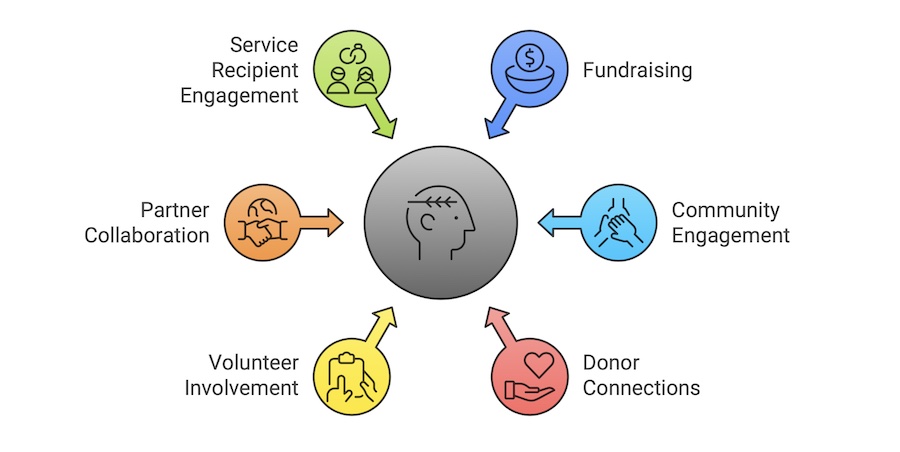Summary
Maximizing Your Impact: How to Align Your Marketing and Mission for Greater Outcomes in Non-Profit Organizations is a strategic framework aimed at helping non-profit organizations (NPOs) effectively integrate their marketing efforts with their core missions to enhance overall impact. Non-profits, driven by social goals rather than profit, must navigate a unique set of challenges, including limited resources and the risk of mission drift. This alignment not only helps in maintaining focus but also fosters deeper connections with stakeholders, ultimately leading to improved funding, volunteer engagement, and community impact. The importance of aligning marketing strategies with a non-profit’s mission is underscored by the necessity of effective communication with diverse audiences, including donors, volunteers, and service recipients. By adopting structured marketing approaches, such as targeted outreach campaigns and performance measurement through Key Performance Indicators (KPIs), organizations can ensure that their initiatives resonate with both their objectives and their audiences. Furthermore, the evolving landscape of digital marketing offers non-profits cost-effective ways to enhance visibility and engagement.
Controversies in non-profit marketing often revolve around the ethical implications of fundraising tactics and the potential for mission drift as organizations seek funding opportunities outside their original mandates. These challenges necessitate a careful balance between resource allocation and mission adherence. By focusing on mission alignment, non-profits can navigate these complexities, foster trust with stakeholders, and ultimately maximize their societal impact. This framework emphasizes the need for ongoing evaluation and adaptation of marketing strategies to ensure alignment with mission objectives. Non-profits can benefit from case studies, collaborative efforts, and targeted training resources to continuously enhance their effectiveness, thereby achieving greater outcomes in their communities. Through a holistic approach to marketing and mission integration, organizations can not only sustain their operations but also drive meaningful change.

Understanding Non-Profit Organizations
Non-profit organizations (NPOs) are structured to serve specific societal goals rather than to generate profit for owners or shareholders. The core mission of a non-profit organization is a defining element that shapes its operations, marketing strategies, and overall impact on society. This mission not only guides all actions and decisions within the organization but also informs how the organization communicates with its diverse audience, including donors, volunteers, partners, and service recipients.
The Role of Key Performance Indicators (KPIs)
To navigate the complexities of their mission, non-profits employ Key Performance Indicators (KPIs) as essential tools for measuring success. KPIs help non-profits track their operational efficiency and societal impact by quantifying various metrics related to fundraising, volunteer engagement, and program effectiveness
- Donor Retention: Measures the percentage of donors who continue to give over time, indicating loyalty and satisfaction.
- Donation Rate: Tracks the frequency and amount of donations received, reflecting the organization’s fundraising effectiveness.
- Social Media Engagement: Assesses the level of interaction with the audience across social platforms, crucial for raising awareness and building community.
- Volunteer Retention and Turnover: Evaluates the organization’s ability to attract and keep volunteers, essential for operational support. By utilizing a KPI Dashboard, non-profits can visualize their performance across these metrics and make data-driven decisions to enhance their strategies and resource allocation, ultimately working towards achieving their mission.
Challenges Faced by Non-Profit Organizations
Non-profits encounter unique challenges that can impact their effectiveness. One significant challenge is mission drift, where organizations may stray from their original purpose in pursuit of funding opportunities or new projects, potentially diluting their impact. Additionally, balancing resource allocation while expanding services and programs poses a challenge, as it requires careful consideration of staff, funding, and infrastructure needs. Non-profit marketers must also work with tight budgets and small teams, making it difficult to fund extensive marketing activities and measure their effectiveness. Crafting unique customer journeys to engage a diverse audience adds another layer of complexity to their marketing efforts. Therefore, aligning marketing strategies with the non-profit’s mission becomes critical to overcoming these challenges and maximizing impact.
The Importance of Mission in Guiding Strategies
The mission statement of a non-profit serves as a compass, guiding the organization’s marketing and operational strategies. All activities—whether awareness campaigns, fundraising efforts, or community outreach—should reflect and support the core mission. By ensuring that marketing initiatives are closely aligned with their mission, non-profits can better engage stakeholders and create a stronger impact within their communities. Through understanding the intricacies of their operational frameworks, including the implementation of KPIs and the significance of a clear mission, non-profits can enhance their effectiveness and achieve greater outcomes.
The Role of Marketing in Non-Profit Organizations
Marketing plays a crucial role in the success and sustainability of non-profit organizations. It serves as both a lifeline and a dynamic indicator of an organization’s health, impacting every aspect of operations from fundraising to community engagement. Effective marketing connects non-profits with diverse audiences, including donors, volunteers, partners, and service recipients, thus facilitating the pursuit of their missions.

Importance of Marketing in Non-Profits
At its core, marketing for non-profit organizations is about attracting support and making a difference. It helps raise awareness, increase funding, recruit volunteers, and build strong communities. Additionally, marketing is vital for improving an organization’s credibility and expanding its outreach efforts. Non-profits often operate on limited budgets, making it essential to utilize cost-effective strategies like digital marketing, which can reach large audiences without significant financial investment.
Strategic Marketing Approaches
Non-profit marketing strategies often involve collaboration with other organizations or businesses for mutual benefit, such as shared marketing campaigns and event sponsorships. Embracing digital marketing techniques—like social media, email campaigns, and content marketing—enables non-profits to engage effectively with their audiences, even with small teams and limited resources. To maximize impact, non-profits should adopt a structured marketing strategy that includes defining specific goals, developing targeted outreach campaigns, and measuring the success of their efforts. The importance of measuring return on investment (ROI) is particularly relevant in the non-profit sector, as understanding which activities yield the best results can inform resource allocation and improve overall effectiveness.
Challenges in Non-Profit Marketing
Despite the advantages of marketing, non-profit organizations face unique challenges, such as navigating tight budgets and competing for attention in a crowded marketplace filled with for-profit entities. Additionally, privacy concerns and evolving data regulations complicate the collection and analysis of customer data, which is critical for demonstrating campaign effectiveness and measuring impact.
Aligning Marketing with Mission
Aligning marketing strategies with the mission is crucial for non-profit organizations seeking to maximize their impact. A non-profit’s mission serves as the foundation for all marketing efforts, guiding the direction and focus of campaigns and outreach initiatives. Understanding the core purpose of the organization is the first step; this includes articulating what change the organization aims to achieve, who it serves, and why it exists.
Understanding Your Audience
Identifying and understanding the target audience is essential for effective alignment. Conducting thorough market research helps organizations grasp the needs, preferences, and behaviors of their audience. This insight informs the choice of marketing methods that will best engage stakeholders and fulfill organizational objectives. Creating audience personas can aid in developing tailored marketing strategies that resonate with specific groups, ensuring that messaging aligns with both the mission and the audience’s expectations.
Choosing Appropriate Marketing Methods
Once the mission and audience are clearly defined, organizations can select appropriate marketing methods. Common strategies include content marketing, social media engagement, email campaigns, event marketing, and public relations efforts. These methods should reflect the organization’s mission while addressing the unique motivations of potential donors and volunteers. For instance, a mission focused on education might benefit from informative blog posts or webinars, while a mission centered on advocacy may utilize public speaking engagements or lobbying activities.
Resource Allocation
Effective alignment also requires wise allocation of resources. Non-profit organizations must evaluate their available human, financial, and material resources to prioritize marketing activities that align closely with their mission and yield the greatest potential impact. This strategic approach ensures that organizations can maximize their outreach without overextending their capabilities.
Measuring Success and Adapting Strategies
Continuous measurement and adjustment of marketing efforts are necessary to ensure alignment with the mission. Organizations should develop clear metrics and key performance indicators (KPIs) to assess the effectiveness of their marketing strategies in achieving their objectives. This allows for adaptations based on current realities and feedback from the target audience, ensuring that the organization remains responsive and effective in its outreach efforts. By integrating mission, audience understanding, appropriate methods, resource allocation, and ongoing measurement, non-profit organizations can enhance their marketing efforts, ultimately leading to greater outcomes and a more significant impact on their communities.
Case Studies
Case studies serve as powerful tools for non-profit organizations looking to align their marketing efforts with their mission. They offer detailed narratives that illustrate the impact of programs and provide actionable insights that resonate with stakeholders.
Importance of Case Studies
Case studies provide an in-depth analysis of individual programs or initiatives, showcasing the challenges faced, solutions implemented, and outcomes achieved. This approach allows organizations to communicate their mission in a relatable manner, offering qualitative metrics that complement quantitative data to capture the human side of their impact. By presenting real-world examples, non-profits can build trust and credibility among stakeholders, including donors and volunteers.

Effective Strategies for Implementation
Dedicated Web Pages
Creating a dedicated section on your website for case studies can enhance visibility and accessibility. This page should be easy to navigate, allowing visitors to quickly find relevant examples of your work. Organizations like Siemens-Healthcare and Avanade exemplify how having an exclusive case study page can enrich user experience and foster engagement.
Incorporating Multimedia
Videos are a particularly engaging format for showcasing case studies. By presenting narratives visually, organizations can communicate their value propositions more effectively. Noteworthy examples include case study videos focusing on primary care improvements and telehealth services, which have successfully attracted attention and engagement from target audiences.
Integration into Newsletters
Including case studies in newsletters can help capture the interest of potential supporters. By highlighting customer satisfaction and success stories, non-profits can create compelling narratives that resonate with their audience and encourage engagement.
Collaborations and External Publications
Partnering with industry-specific publications can amplify the reach of case studies. Featuring case studies in articles or advertorials within healthcare journals can provide non-profits with targeted exposure to professionals seeking solutions and insights in their field.
Testimonials as Supporting Evidence
Collecting testimonials from program participants and stakeholders can enhance the impact of case studies. These personal stories not only provide qualitative evidence of program success but also help to build emotional connections with potential supporters, thereby strengthening trust and engagement.
Tools and Resources
Training and Capacity-Building Resources
Training and capacity-building resources are essential for nonprofit organizations aiming to measure their impact effectively. These resources can take various forms, including webinars, workshops, and online courses, which equip organizations with the necessary skills and knowledge. By engaging in these training opportunities, nonprofits can enhance their understanding of impact measurement frameworks, ensuring they can evaluate their work meaningfully.
Collaboration Opportunities
Collaboration plays a pivotal role in impact measurement by fostering an environment where organizations can learn from each other and share best practices. Opportunities for collaboration include conferences, forums, and networking events. Such interactions enable organizations to pool resources, share data, and leverage expertise, which can lead to more comprehensive and accurate impact assessments.
Analyzing and Interpreting Results
A comprehensive understanding of how to identify goals, select appropriate indicators, and establish data collection methods is crucial for effective impact measurement. This process allows organizations to analyze results and communicate findings transparently, thereby enhancing their capacity to demonstrate the effectiveness of their programs. For instance, evaluating long-term outcomes, such as literacy rates or job opportunities, provides valuable insights into program success and areas for improvement.
Data Visualization Tools
Utilizing data visualization tools is another effective strategy for presenting data in an accessible and engaging manner. Charts, graphs, and other visualizations can help stakeholders comprehend complex data more easily. Additionally, integrating storytelling techniques can illustrate the impact of an organization’s work, thereby resonating with stakeholders on an emotional level.
Technology and Online Tools
The adoption of technology can streamline the impact measurement process. Tools such as online surveys (e.g., SurveyMonkey, Typeform) and data visualization software (e.g., Tableau, Google Data Studio) can enhance data gathering and presentation efforts, making it easier for nonprofits to analyze and share their impact. For example, nonprofits focused on environmental conservation can utilize GIS mapping tools to visualize their contributions to local ecosystems.
Mission Alignment Strategies
Mission alignment is crucial for ensuring that all organizational resources are directed toward achieving defined goals. Aligning mission, methods, and resources can foster trust and credibility among stakeholders while facilitating more accurate impact assessments. Organizations should strive for coherence among their mission, strategies, and resource allocation to operate efficiently and maximize their positive impact.


